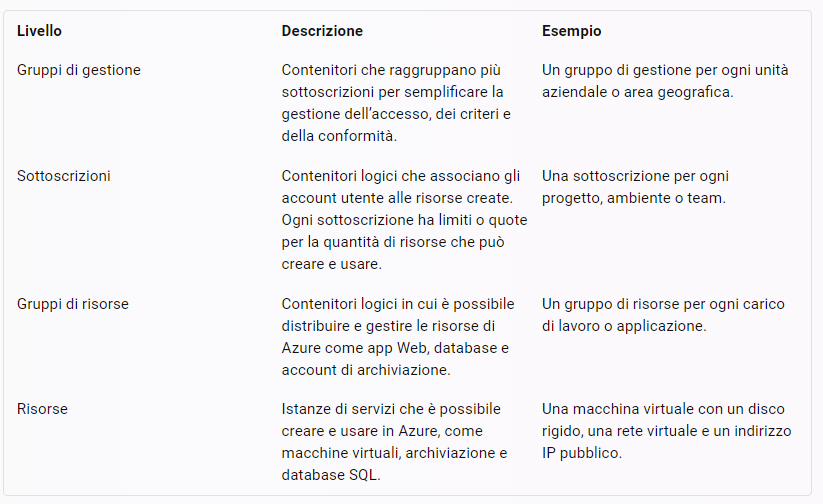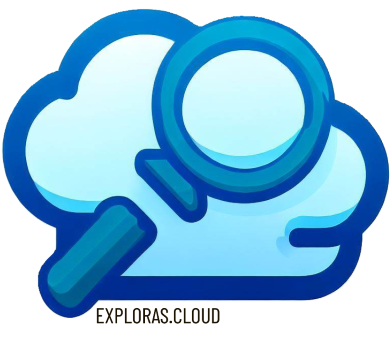Definizione di risorsa cloud.
Le risorse cloud sono i componenti di base che permettono di creare e gestire applicazioni, dati e infrastrutture in un ambiente virtuale. Esistono diversi tipi di risorse cloud, come le macchine virtuali, i servizi di storage, le reti, le funzioni, i database, i container e così via. Ogni risorsa cloud ha delle caratteristiche specifiche, come la capacità, la disponibilità, la scalabilità, la sicurezza e il costo. Gli hyperscaler cloud sono i fornitori di servizi cloud che offrono una vasta gamma di risorse cloud a livello globale, con una elevata qualità e affidabilità. Alcuni esempi di hyperscaler cloud sono Microsoft Azure, Amazon
Comprendere cosa sia una risorsa cloud permetterà di comprendere le definizioni del cloud che a loro volta permetteranno di comprendere la definizione di un ecosistema informativo cloud native, come raccontato nell’articolo Ecosistema informativo cloud native.
Le basi
Una risorsa cloud è un servizio offerto da un fornitore primario del cloud anche denominato hyperscaler, a causa della sua capacità di erogare servizi, supposti, implicitamente ad alta scalabilità.
Le risorse cloud sono le istanze di servizi che come utente posso acquistare ed utilizzare per comporre una sistema informativo cloud.
Esempi di risorse cloud
Qualsiasi servizio di base presente in un sistema informativo classico può essere individuato erogato da una o da un insieme di risorse cloud.
L’offerta di risorse cloud (servizi) quindi è molto ampia. Ogni Hyperscaler le classifica secondo specifiche metriche a volte guidate più dal marketing.
Ma alla base abbiamo disponibile quasi tutti i servizi rappresentabili in uno stack ISO/OSI.
Manca l’hardware ed i servizi energetici, nativamente forniti dal fornitore cloud. In sostanza le risorse cloud nascono nativamente per garantire alta disponibilità locale.
In cloud non acquisto un rack hardware ma al più una macchina virtuale host.
In cloud non acquisto un apparato di rete ma un servizio di rete.
Per i servizi applicativi a pagamento di base database, firewall etc. quando richiesto dovrò comprare licenze software quando non siano open; in quel caso come sempre dovrò pagare un servizio di supporto per avere garantita la continuità del servizio.
In cloud si parla di configurazione, parametrizzazione, allocazione, deallocazione avvio, spegnimento delle risorse cloud.
Esse possono essere gestite da specifici pannelli di controllo, obbligatoriamente resi disponibili dal fornitore cloud.
Posso operare in molti casi comunicando tramite linguaggi di script per una loro configurazione e veloce gestione del change.
Il termine risorsa cloud, viene impiegato nel blog per indicare le istanze di servizio
Classificazione delle risorse cloud.
Le risorse cloud sono classificabili in base al modello di servizio erogato se di tipo IasS, PaaS, SaaS.
Normalmente le risorse sono classificabili e identificate dal fornitore del cloud per il livello ISO / OSI di servizio da esse rappresentate.
Per esempio troviamo le risorse di tipo network (VPN, LAN etc), di tipo storage (ARCHIVI, basi dati, data lake etc) o di trasporto dati o infine di tipo applicativo (servizi paas come Kubernets, IaaS come VM etc).
Data l’ampio numero di risorse cloud disponibili ogni fornitore primario utilizza vari criteri di classificazione delle risorse.
Nel seguito ne presento alcuni.
Classificazione Risorse cloud in Azure
Per organizzare e gestire le risorse cloud, Azure offre quattro livelli di gestione: gruppi di gestione, sottoscrizioni, gruppi di risorse e risorse. Ogni livello ha una funzione e una relazione con gli altri livelli. Ad esempio, i gruppi di gestione consentono di semplificare la gestione dell’accesso, dei criteri e della conformità per più sottoscrizioni. Le sottoscrizioni associano logicamente gli account utente alle risorse create. I gruppi di risorse sono contenitori logici in cui è possibile distribuire e gestire le risorse di Azure come app Web, database e account di archiviazione.
Oltre ai livelli di gestione, puoi anche usare gli standard di denominazione e l’assegnazione di tag per organizzare le risorse cloud. Gli standard di denominazione ti aiutano a identificare rapidamente le risorse associate a carichi di lavoro, ambienti, gruppi di proprietà o altre informazioni importanti. L’assegnazione di tag ti consente di aggiungere metadati personalizzati alle risorse

per facilitare la gestione dei costi, delle operazioni, della sicurezza, della governance e dell’ottimizzazione del carico di lavoro.
Infine è possibile utilizzare i tag per classificare i dati in base alla riservatezza e all’impatto aziendale per identificare i rischi.
Seguono alcune piccole guide che possono essere utili a comprendere l’organizzazione delle risorse in Azure
- Organizzare le risorse di Azure in modo efficace
- Diagramma risorse di Azure
- Determinazione dei costi e ridimensionamento delle risorse di Azure
Classificazione delle risorse in AWS
La classificazione delle risorse cloud in AWS è simile a quella di Azure, ma usa termini diversi. Le risorse cloud sono le istanze di servizi che puoi creare e usare in AWS, come macchine virtuali, archiviazione e database. Per organizzare e gestire le risorse cloud, AWS offre quattro livelli di gestione: organizzazioni, account, servizi e risorse1. Ogni livello ha una funzione e una relazione con gli altri livelli. Ad esempio, le organizzazioni consentono di creare e gestire gruppi gerarchici di account1. Gli account sono i contenitori logici che associano gli utenti alle risorse create1. I servizi sono le categorie di prodotti che offrono funzionalità specifiche, come calcolo, storage, networking e database1. Le risorse sono le istanze dei servizi che puoi creare e usare in AWS, come macchine virtuali, bucket S3 e tabelle DynamoDB1.
Oltre ai livelli di gestione, puoi anche usare gli standard di denominazione e l’assegnazione di tag per organizzare le risorse cloud. Gli standard di denominazione ti aiutano a identificare rapidamente le risorse associate a carichi di lavoro, ambienti, gruppi di proprietà o altre informazioni importanti2. L’assegnazione di tag ti consente di aggiungere metadati personalizzati alle risorse per facilitare la gestione dei costi, delle operazioni, della sicurezza, della governance e dell’ottimizzazione del carico di lavoro2. Puoi anche usare i tag per classificare i dati in base alla riservatezza e all’impatto aziendale per identificare i rischi3.
Referenze
Classificazione delle risorsse cloud per GCP
La classificazione delle risorse cloud in GCP si basa sulla gerarchia delle risorse e sui servizi monitorati. Le risorse cloud sono le istanze di servizi che puoi creare e usare in GCP, come macchine virtuali, archiviazione e database. Per organizzare e gestire le risorse cloud, GCP offre una gerarchia di risorse che comprende quattro livelli: organizzazioni, account, progetti e risorse1. Ogni livello ha una funzione e una relazione con gli altri livelli. Ad esempio, le organizzazioni consentono di creare e gestire gruppi gerarchici di account1. Gli account sono i contenitori logici che associano gli utenti alle risorse create1. I progetti sono le unità di base per la fatturazione, l’autorizzazione e la configurazione delle risorse1. Le risorse sono le istanze dei servizi che puoi creare e usare in GCP, come macchine virtuali, bucket Cloud Storage e tabelle Cloud Bigtable1.
Oltre alla gerarchia delle risorse, puoi anche usare i servizi monitorati per classificare le risorse cloud in base al tipo di prodotto o funzionalità che offrono. I servizi monitorati sono le categorie di prodotti che vengono monitorati da Cloud Monitoring, come Compute Engine, Cloud Storage, Cloud SQL e altri2. Ogni servizio monitorato ha uno o più tipi di risorsa monitorata associati, che definiscono le proprietà e i metadati delle risorse che appartengono a quel servizio2. Ad esempio, il servizio monitorato Compute Engine ha i tipi di risorsa monitorata gce_instance, gce_disk, gce_autoscaler e altri2.
Si possono trovare maggiori informazioni nei seguenti approfondimenti:
Referenze:

